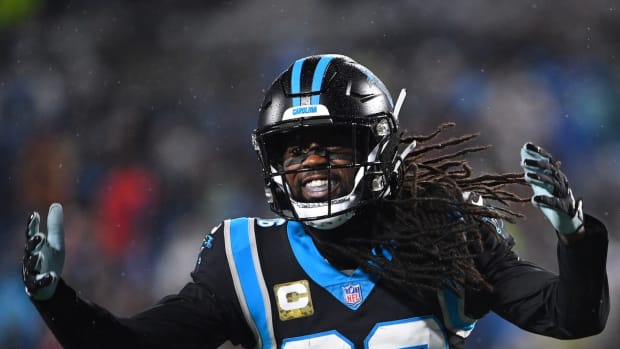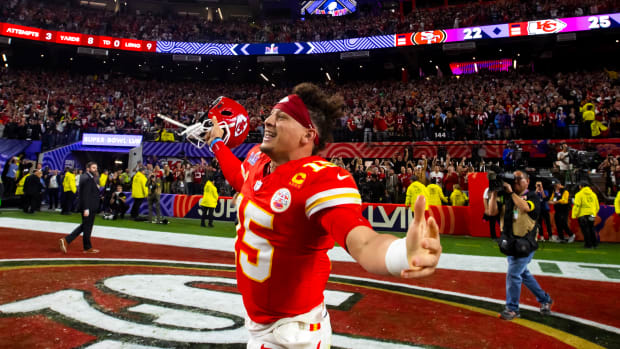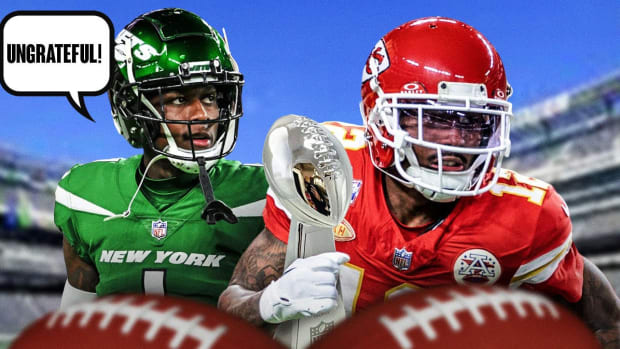Just How Much Control Did Baker Mayfield Have in Oklahoma’s Air Raid Offense?
Part 11 of our draft season series on Baker Mayfield, the 2018 draft’s most fascinating prospect on and off the field
It is the annual rite of passage for the Air Raid quarterback coming out of college hoping to make a career in the NFL. An NFL coach turns on the tape and marvels at the production of an offense he might have once dismissed as gimmicky. History has told him these quarterbacks are products of a system unsustainable in the modern NFL. Patrick Mahomes fielded the question this time last year, and Baker Mayfield has heard it all spring: What would you say... you do here?
You can forgive NFL coaches for their skepticism considering the string of Air Raid quarterbacks who have put up prolific passing numbers in college then been slow to adapt to the NFL, or bombed entirely (Air Raid QBs Case Keenum and Graham Harrell claim the Nos. 1 and 4 spots, respectively, on the FBS all-time passing yardage list). At some point, the stats do, in fact, lie.
That’s where Oklahoma head coach Lincoln Riley comes in. As OU’s head coach, offensive coordinator and QBs coach, Riley has been a go-to resource for numerous coaches working to learn more about Mayfield’s responsibilities, proficiencies and deficiencies within Riley’s version of the Air Raid. Additionally, knowing how those factors have changed over time gives coaches an idea of how quickly they can expect Mayfield to develop in a league that lacks patience with first-round quarterbacks.
As our series on Mayfield continues, we visit with one of his biggest advocates for a film-room session at the OU football facility, with the goal of going beyond the gaudy statistics to figure out just how much Mayfield has grown under Riley, and how quickly he might grow in the NFL.
Before the lights go down and the film clicks on, Riley answers everybody's first question: Just how much responsibility does Mayfield have within the framework of the offense? In other words, how much of it is Riley, and how much is Mayfield?
“He’s probably got more responsibility here than he would have with any NFL team he would go to,” Riley says.
“Some places do it where you hold up a board on the sideline and he tells everybody what to do and he doesn’t have any communication responsibilities, but he plays a larger hand here, a pivotal role.
“Mentally, he’s the best one I’ve ever been around, and I’ve been around some good ones. There’s not gonna be a guy walk in and process what this guy can process. That’s not gonna be an issue at the next level, regardless of the system or amount of verbiage.”
Alrighty then. For the film session, Riley’s staff isolated a handful of clips to show the difference experience makes. Says Riley: “These should tell you what a lot of these coaches want to know from me—responsibilities, protections... stuff you can’t tell just from watching the film.”
Pre-snap adjustments
2015 vs. Texas. Second quarter, 13:38 remaining. Texas 14, Oklahoma 0. 2nd-and-14. Ball on OU 33.
The Longhorns are representing man coverage with a single-high safety, a six-man pressure aimed to send a free blitzer between the right guard and right tackle.
“We’re in a play-action protection, where we’ve got a route where we really like with Dede [Westbrook] at the bottom," Riley says. “They’re bringing this weak-side pressure up top. The way this is set up, we can’t block him. What we would’ve wanted him to do is change the protection, stayed with this down on the bottom, and this is a 60-yard touchdown pass, but Baker probably didn’t have the confidence to change the protection.”
Mayfield looks briefly at a well-covered hitch before taking the sack.
2017 vs. Oklahoma State. Second quarter, 14:03 remaining. Oklahoma 21, Oklahoma State 17. 1st-and-10. Ball on OU 15.
The Cowboys are showing an almost identical pressure, with sophomore linebacker Calvin Bundage attacking the right side of the line with the defense rotating to man coverage with a single-high safety. Mayfield recognizes the linebackers creeping slowly and steps toward his offensive line to change the protection. The line will slide right and the running back will move from Mayfield’s right hip to his left, putting the right tackle on Bundage.
“Similar situation,” Riley says. “We have the route that we want up top this time, and you can see him change the protection. We get the same blitz, both edges. But now he slides the line to that side, and our [running] back is not working across the quarterback’s face to make the block. This is important, because not only does he get the blitz picked up, but he sends the strength to where we want to go with the ball. If he doesn’t do this, he’s not going to have time to get it off and really get into this throw. It’s the difference between a 10-yard completion and an 80-yard touchdown because he hits him on the run.”
The receiver closest to the right sideline, Marquise Brown, is running a “burst” route, in which the receiver takes several steps toward the goalposts, hesitates as if he’s running a lazy route, then flashes across the middle of the field. The stall is an often-successful attempt to catch the corner flat-footed, but it takes time. “We wanted to get a hat on a hat, sure, but it’s also about matchups,” Riley says. “No. 1 from Oklahoma State [Bundage] was one of their best blitzers, and we want an OL on him to get a nice wide pocket as opposed to telling the running back to block him.
“What you and I just took 2-3 minutes to talk about, Baker’s processing all that in a matter of seconds. This is why our yards per play was so high. His understanding this year was on a different level.”
Making the throws
2015 vs. Tulsa. First quarter, 12:32 remaining. 3rd-and-goal. Score tied 0-0. Ball on Tulsa 3.
All three Kansas linebackers bit on the play-action, and Mayfield has future pro Sterling Shepard flashing across the middle, having beaten his man. Mayfield throws a bullet off Shepard’s fingertips, high and behind.
“This is the third game of the season, and we’re running play-action glance here,” Riley says.
“We’ve got what we want on the play-action but he’s rushed, the feet are just a little bit erratic. We’ve got a clean pocket so he should be stepping into this throw, but his first step is back to that right foot, and a lot of times where you finish a throw is where you’re gonna miss. He throws it way too hard. It’s just kind of rushed and frantic.”
2017 Big 12 title game vs. TCU, Second quarter, 4:21 remaining. 2nd-and-3. Oklahoma 17, TCU 14. Ball on TCU 7.
Again the linebackers bite on the play action, though not nearly as hard. The ball has to fly clear of a linebacker’s outstretched hand, then find tight end Mark Andrews with three defenders within four feet of him when he catches the ball.
“Same type of throw, and you can see the balance is much better,” Riley says. “Nice and smooth, finishing forward. Everything is just more calm, more confident. Feet in a good spot and he threads this one pretty good. This had to be threaded a lot more than the other one; he’s not nearly as open, but it’s a softer throw and there’s just more anticipation. It looks like a guy out there throwin’ 7 on 7.”
Understanding personnel
2016 vs. Ohio State. Third quarter, 10:04 remaining. 3rd-and-7. Ohio State 42, Oklahoma 17. Ball on OU 48.
“This was when they beat the shit out of us,” says Riley, still bitter.
Ohio State is bringing six rushers, counting a delayed blitzer. They’re in man coverage across the board with a single high safety. With the X receiver running a hitch and his slot receiver, Andrews, running a fade, Mayfield makes the right decision to toss it up to Andrews, who is being checked by Damon Arnette, the starting cornerback who as of last August owned the Buckeyes’ record time in the three-cone agility drill. The ball is overthrown and out of reach.
“Decision-wise, we’re fine here,” Riley says. “But this is part of knowing your personnel on defense and offense. Ohio State is really athletic in the secondary, as everybody knows, and he’s got a shot here to Andrews on the inside fade ball, and there’s a little bit of pressure.
“There are two issues here. He’s throwing to a 6' 5" receiver, and against Ohio State, you’re not running by those DBs. And you’ve gotta know, defensively, they’re very aggressive on any type of vertical ball.”
2017 vs. Ohio State. Fourth quarter, 10:11 remaining. 3rd-and-8. Oklahoma 24, Ohio State 13. Ball on OSU 25.
Riley’s Revenge. It’s time to ice this thing; the Sooners are running the same offensive concept, and the Buckeyes are in the exact same defense. This time it’s six-foot speedster Jeff Badet running the fade from the slot. Mayfield takes the snap, eyes the hitch on the outside to confirm man coverage, then flicks a ball that hits Badet in the hands, falling out of bounds at the 3-yard line. Initially ruled incomplete, the call is overturned on review. First-and-goal.
“Now we’ve got a smaller guy who’s faster than Andrews, but the QB recognizes what Ohio State is good at, and you see where this ball is thrown, low and away, and that’s exactly how we want it thrown,” Riley says. “You’re not simply going to beat Ohio State over the top. If you throw it over the top here, the safety is going to have a chance to make a play on the ball. You just see here that Baker has a better sense of how we want to attack them, how they’re going to play us and where they are weak. Both plays, he makes the right decision on where to go with the ball, but the great ones think about where exactly that ball needs to go.”
Making progression reads
2016 vs. Baylor. First quarter, 8:45 remaining. 3rd-and-5. Oklahoma 7, Baylor 0. Ball on the Baylor 42.
The OU offense contains a multitude of plays requiring full progression reads in the classroom, which become whittled down to one, two or three passing options in practice, based upon the situation and the quarterback’s best guess at the defensive coverage before the snap. Mayfield’s progression on this five-step drop goes from left to right: the fade from the single receiver, the deep cross for the inside trips position, then the 10-yard curl route from the outside receiver. But Mayfield hesitates. He doesn’t like the fade, and Dimitri Flowers is covered down the middle of the field. He throws it anyway and misses.
“This is a staple of our five-step game,” Riley says. “This thing ends up clearing late, but it’s an example of him hanging onto the first read too long. He’s looking at the vert down here, which he could’ve taken, but it wasn’t a great matchup—not our best player. He’s off that, on to No. 2, he’s got a bit of pressure, and his decision is if this defender is carrying this crossing route [if the linebacker turns his hips and runs with the inside receiver, he’s “carrying” the route]. He may get there, he may not, but this third option is gonna be closed up by the time you get to it. He’s waited too long when his progression says I need to move on.”
2017 vs. Oklahoma State. Third quarter, 12:56 remaining. 3rd-and-9. Score tied 38-38. Ball on the OU 8.
Same route concept, and once again, the No. 1 option is covered, and the inside trips crosser, this time Andrews, is being carried by the linebacker. Mayfield steps up into the pocket as he reads through the defense, escaping some outside pressure, and makes the correct third-read throw while dodging to his right. It’s not the flashiest play of his Oklahoma career, but it’s a tiny masterpiece.
“I like that he didn’t hang on to this too long, and even though this is a good matchup with Andrews, he moves onto the curl,” Riley says. “Good anticipation. He’s sliding in the pocket but still gets a good enough base to deliver an accurate throw, and if this isn’t right on time, we’re probably going to have to punt. Snapping through the progression, even when the time to throw isn’t ideal.”
All in all, Riley’s take on the film is a glowing endorsement of Mayfield’s growth and ability, though it’s fair to wonder if Riley would do anything but sing Mayfield’s praises when NFL folks come calling. He says he doesn’t believe teams are dwelling anymore on the off-field questions about Mayfield; they’ve moved onto what happens between the white lines. “Actually,” Riley says, “they’ve had a lot of the same questions you have.”
• Question or comment? Email us at talkback@themmqb.com.






































